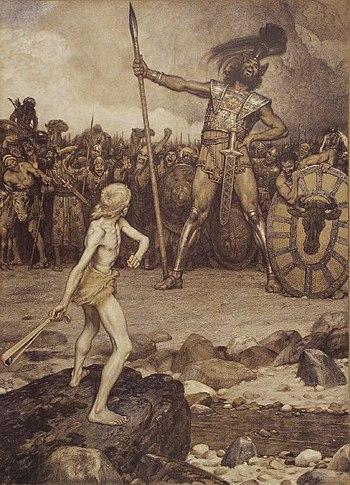
“David and Goliath” by Malcolm Gladwell moldered on my nightstand for many months before I recently picked it up. I had reservations about delving back into a Gladwell book. Not only had I read “The Sports Gene,” which to me did a much better job of exploring the 10,000-hour rule Gladwell wrote about in “Outliers,” but I was channeling the Gladwell fatigue emanating from many quarters, and which I suffered from a bit myself. I’ve read his books and his writing in the New Yorker for years, which has resulted in a creeping intolerance for Gladwell’s approaches to framing ideas and his style of writing. This feeling of Gladwell déjà vu isn’t helped by the fact that his books’ designs are so monotonous — white cover, stark type, single iconic image, same trim size.
I waded in thus encumbered with doubts and reluctance, and vowed to limit my initial excursion into Gladwellia to a dash across the border to see if I’d return later.
Needless to say, the book drew me in, and I finished it within a few busy days.
What caught my attention from the start were the subtleties Gladwell uncovered in the David and Goliath story. We’ve generally absorbed David and Goliath as the story of the little guy surprising the big guy, but it turns out to be much more subtle and interesting than that when the context is better elucidated and some historical elements are expounded upon. Gladwell does this deftly and economically, getting you into the heart of the matter before you know it.
Innovation is one of Gladwell’s favorite topics, and the book makes you think differently about what it takes to be innovative. Our cliché about innovation is that someone has to be able to “think outside the box,” but Gladwell spends much more time exploring how adversity can bring forth personalities capable of changing the world. It’s not just the ability to think outside the box that matters — one has to possess a personality capable of persevering through rejection, repudiation, and setbacks in order to make the world work differently. Such personalities are often hardened by setbacks encountered at a young age.
The type of setback matters, as does the response to it. These concepts are captured using the analogy of bombings — “direct hits,” “near misses,” and “distant misses.” Gladwell draws on how the Blitz during World War II affected London and England in general. Instead of instilling panic, as the Nazis had hoped and as British leadership had feared, there were three actual effects. First, those who were hit directly died, and were unable to spread panic. Those who suffered near misses were injured, and also were unable to spread panic. So the vast majority of Londoners at the time suffered “distant misses” — sirens, a few minutes of hiding in the basement, maybe a distant explosion, and then the resumption of daily life. In this manner, most of the population became indifferent to the bombings, believing through experience that they were unlikely to be hit. In fact, many felt invulnerable after a while, as if charmed. As this cycle continued, the city became psychologically impervious. The German plan had backfired, as the British moved into a confident retaliation mode.
Dyslexics, orphans, and victims of prejudice are profiled. As Gladwell writes, some suffer direct hits, and their setbacks take them out of the game. Others are near misses, and suffer a little but survive. And some are distant misses, people who come out with a galvanized sense of self after learning to deal with their hardships or differences. These people are the focus of the book, as are the limits of power (and its significant potential to backfire if mishandled).
“David and Goliath” covers a lot of ground, and there are many branches from the main river that bisects it. One interesting branch for me was a section on “tricksters,” who come in two varieties — those who fool their adversaries into doing exactly what they want, and those who “fake it until they make it.”
“Faking it until you make it” is a common thread behind success (and probably explains the “impostor syndrome” so many adults feel at some point in their careers). It is a thread that many traditionalists find hard to accept. A great story in the book along these lines comes from Brian Grazer, a major Hollywood producer of hits like “Apollo 13,” “A Beautiful Mind,” “8 Mile,” “24,” and “Friday Night Lights,” to name a few. (As an aside, Grazer has hair that competes with Gladwell’s for antigravity effect.) A dyslexic, Grazer learned as a survival adaptation how to talk his way through any situation. He became a consummate and confident dealer of concepts and negotiator at a young age. He also learned to persist and to take the lead. So, when as a young man he got a job in the mailroom at Warner Brothers, he would make calls and work deals from this position, introducing himself as, “Brian Grazer of Warner Brothers.” He didn’t mention he was working in the mailroom at the time.
Many stories are agonizing to read — there are stories about the civil rights movement, the religious conflicts in Ireland, and others. The moral of some of these stories can be murky at best. This is one unusual lesson about change the book teaches, as noted above — most success stories are full of compromises, exchanges, chicanery, and actions we might find hard to accept in a purist moral framework or as an enforcer of polite society.
This purist moral framework itself comes into question when the harsh California “Three Strikes” law is put under the microscope, in a larger section dissecting the notion that rational cost-benefit calculations by members of society lead to predictable outcomes. That is, make something more costly, and a rational person will choose not to engage in that activity. Beyond questioning whether criminals are rational, the section also examines how carefully power has to be wielded, and how simplistic cost-benefit approaches can backfire in complex ways.
One of the most horrible sections of the book deals with a physician discovering viable treatments for childhood leukemia. In our modern medical miracle world, we often forget the devastating and horrendous diseases our predecessors suffered through and somehow found a way to treat, prevent, and cure — from polio to rheumatic fever to childhood leukemia, the realities of these illnesses are jarring and nauseating. But one man, who had suffered a very difficult upbringing, had the nerve and tenacity to essentially mistreat children for a period, causing them great pain, going against the orthodoxy, demanding results, and angering many around him — all for the sake of finding a treatment. His own childhood adversity created a mentality capable of inflicting hardship on others for the purpose of a greater good, and also gave him an appreciation that hardships were generally temporary. He knew pain was temporary. He had experienced it himself.
There are two general dispositions I could see benefiting from this book. First, there are those people who naturally and habitually push against the status quo. For them, the book will likely be affirming and energizing, and may clarify that while their driven personality can cause friction, that friction is necessary and their ability to withstand it a sign of the innovator or change agent. Second, there are people who have to deal with innovators but who don’t quite understand them, what drives them, and why they sometimes seem obnoxious. For them, this book may help reveal the inner workings of those stubborn, driven, and sometimes troublesome individuals, and also create second thoughts about the cost of suppressing them contrasted against the benefits of supporting them.
David was a distant miss. He had never seen war, but he’d seen his flock terrorized by wild animals, and had acquired a sling and the skill to use it. He’d survived many attacks, and had taken out many attackers. In his own way, he was battle-hardened, but the battle was not the one he was about to enter into with the giant Goliath. It did not matter. The lessons absorbed elsewhere transferred that day, his confidence in his abilities was high, and the giant fell. There were many with slings there that day, but only one had the personality to take on a giant.
One of the most unpleasant lessons in the book is that hardships can toughen people, and we need people with those hard edges in order to make progress. Gladwell asserts that this unpleasantness is important to progress. If we keep everything pleasant, we make no progress. As scholarly publishing is in some turmoil about access models and who pays what, the psychologies of criticism, attack, accommodation, manners, and progress have become relevant.
But make no mistake — the lesson of David and Goliath is not that the small upstart or the most unpleasant person wins. Rather, it is that those who have suffered hardships, who have gained a level of callousness, who have had significant skills fired in the kiln of adversity, and who are intolerant of the status quo — these are the people who most often prevail. We might not always like them, they may do things we think are inadvisable, but they are our giant-killers.
P.S. Gladwell needs to make his next book bigger and with a red cover. At this point, his books’ generic designs are working against him.
Discussion
16 Thoughts on "Book Review — "David and Goliath" by Malcolm Gladwell"
Good review but from what is abstracted, revelation of the ‘school of hard knocks’ is not new.
It’s tempting to reduce it in that way, and that’s part of the reason I hesitated to read it. I thought, “I know the lessons of David and Goliath,” and so forth. Well, either it’s Gladwellian magic or the book actually has a lot of layers, intricacies, subtleties, and great stories.
For instance, the concept of the limits of power, how misapplied power backfires, and how hidden power is triggered and released, all go beyond “the school of hard knocks” simplicity. How the interplay between personalities in an insurgent movement occurs — who lulls the incumbents vs. who sneaks up and undermines them — is really interesting. How we overestimate the power of the powerful, how the powerful overestimate their power, etc., are all brought to life in really interesting ways.
As for the individuals who create change, the way some compensate for congenital defects and how these compensatory skills set them apart is also far different from “the school of hard knocks” simplicity.
So, while it’s tempting to think of “David and Goliath” as something you already understand, very quickly the book surprised me with twists on the story that took me in new directions, and followed it up with really interesting explorations of the nature of power, the assertion of power, and how power backfires or comes from surprising wellsprings.
“Rather, it is that those who have suffered hardships, who have gained a level of callousness, who have had significant skills fired in the kiln of adversity, and who are intolerant of the status quo — these are the people who most often prevail.”
It seems to also be those willing to take a chance – a risk. But the beauty is that they may not even perceive it as a risk. They simply think – it will work OR whatever could go wrong is worth it OR we can fix it later.
It’s interesting when thinking about the “school of hard knocks” to also notice that the same hard knocks seem to inspire different lessons. Some people come up strategizing and fighting and others become lifelong victims (and there’s a whole spectrum between that). So there’s more to this than simply hard knocks.
This quote, I worry, might well apply to people like Adolf Hitler.
You’re right — again, this is why the abuse of power is part of story. On a smaller scale, the story of the “Three Strikes” law in California vs. another approach taken by people who didn’t depend on “big power” is illustrative. Hitler believed in “big power.” It has its limits, and often backfires.
Stubbornness is indeed a key trait for innovative people, for two opposite reasons. First there is the well known wall of skepticism to get through, but there is also the hoard of helpers who threaten to pull the new idea apart by taking it in all directions at once.
Great review. It is so difficult to try to “explain” how his books make you think. I loved the bit about dyslexia, and about the doctor and leukemia. I would love to meet him!
The leukemia doctor was Sidney Farber. If he tried his “experiment” today he’d be reviled. Not to mention no self-respecting IRB would ever allow it.
He knew that folate stimulated the bone marrow and leukemia was a disease affecting the bone marrow. So he gave some of his patients folate. They promptly died.
As a result he went looking for a compound that suppressed folate. He found one and gave that to some of his patients. He induced a [temporary] remission in 10 of 16 patients. They did eventually die, but he was on to something. See http://www.nejm.org/doi/full/10.1056/NEJM194806032382301
Everyone knows the second part of the story. Few people remember the first part.
I intend to read the link you sent through, what is IRB? Maureen
IRB = Institutional Review Board
https://en.wikipedia.org/wiki/Institutional_review_board
Having yet to read the book, it might be unfair to comment on the substance of it more than has been done (but I don’t need to abide by the rules any more than David). I’m sure Gladwell weaves a skilful web and has a reader disagreeing only to find that his disagreement is anticipated and countered. That Gladwell writes well is certainly not in doubt. That the book is perhaps but a skilful replay of an old moral tale is not a criticism. To ‘see through’ Gladwell and continue to read and enjoy him is perhaps the highest accolade for a writer. Gladwell is good writer and good entertainer. I’m pretty sure Goliath had as many or more ‘hard knocks’ before he got to face the simplicity of a shepherd’s sling. I would also think it likely that following the encounter those who make the rules on such representational fighting banned the sling as an unfair weapon ~ or made the contest one of slings and arrows. I have no idea what happened to David long term. Maybe he became a big man. His future post-Goliath seems rather important to know. I suppose I could read the Bible.
Nearly 6 months after publication, the hardcover edition is still ranked in the top 100 on Amazon and has generated 1200 reviews. I doubt Little, Brown will change anything for Gladwell’s next book.
I know. I think I’m the one who will have to adjust. It’s funny how this did make me judge a book by its cover, but in a different sense — more about it looking like another widget out of the Gladwell factory.
I’m afraid Gladwell is no longer an author who produces books, but a brand that produces products.
Indeed – a brand factory for which there is a good send-up:
http://malcolmgladwellbookgenerator.com


